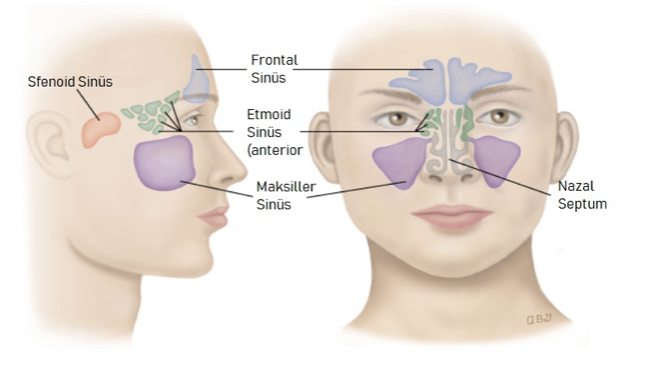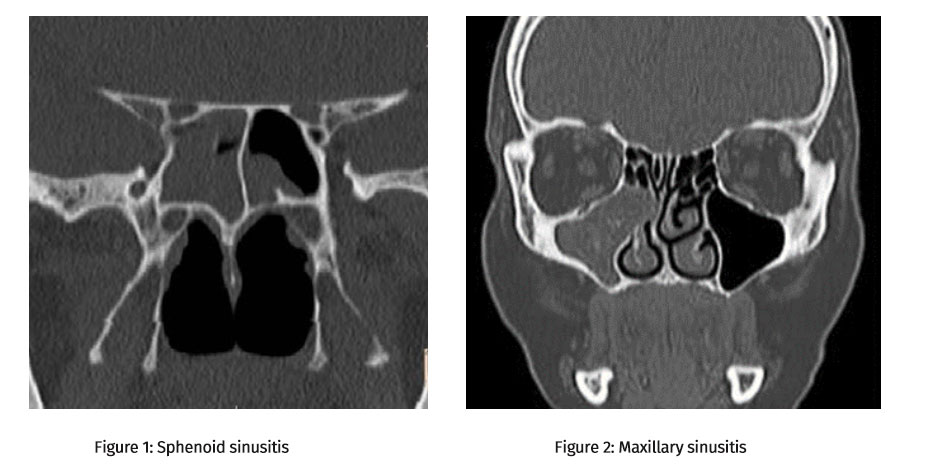
Sinus structures, also called paranasal sinuses, are 4 pairs of air spaces located within the facial bones and each is named along with the bone structures in which they are located (maxillary, ethmoid, frontal and sphenoid sinuses). The sinuses, which are partially present at birth, are almost completely developed around the age of 12-14. It has functions such as humidifying the respiratory air, making secretion, making lighten the skull bones and contributing to the resonance of the voice. All sinus cavities drain into the nose and because of this close relationship, sinus infections are often referred to as rhinosinusitis, as they concern both the nasal mucosa and the sinus mucosa at the same time.
Sinus infections are classified as acute, subacute, and chronic sinusitis. Acute sinusitis is sinusitis that starts suddenly and heals completely in less than four weeks. The term subacute sinusitis is used for sinusitis that lasts for 4-12 weeks. Sinusitis that lasts longer than 12 weeks is called chronic sinusitis.
What are the reasons that facilitate sinusitis?
Some structural or functional pathologies that disrupt the nasal breathing or prevent the ventilation of the sinuses can cause sinusitis. These are nasal bone curvatures, nasal polyp formation, lower concha growths, anatomical disorders in the middle nasal meatus, conditions that cause edema in the nasal mucosa (such as viral upper respiratory tract infections, allergic rhinitis, pregnancy and hormonal disorders), and tumors. In such cases, sinus drainage is disrupted and then it initiates sinusitis by preparing a suitable ground for bacterial growth. Apart from bacterial causes, there are also fungal sinusitis that occur mostly in chronic sinusitis cases. Fungal sinusitis are especially seen in patients with diabetes and immune system deficiency and sometimes they present as severe infections.
What are the symptoms of sinusitis?
Patients most frequently describe complaints of headache, nasal congestion, posterior and anterior nasal discharge. In addition, symptoms such as bad breath (halitosis) cough, pain in the ear, toothache, fever, decrease or loss of sense of smell, weakness and fatigue can be seen. Chronic sinusitis patients generally experience these complaints as milder.
The location of the headache can vary depending on which sinus is affected. It is usually seen as pain in the cheeks, forehead, between or behind the eyes and upper teeth. If the color of the discharge turns yellow-green and darkens, it means that a possible bacterial infection has developed.
How is sinusitis diagnosed?
Observation of inflammatory discharges during endoscopic examination of the nose is the most important finding in terms of sinusitis. During this examination, anatomical problems that facilitate sinusitis, polyps in the nose, tumor or fungal infections, and allergy-related changes can also be detected. Sometimes, facial edema, enlarged lymph nodes in the neck, pharyngitis and post nasal drip may accompany the disease.
Plain X-rays (such as Waters, Caldwell and lateral cranial radiographs), which were frequently used in the past in the detection of the disease, are not used as widely today as before. If our examination findings are sufficiently present, it is enough to switch to medication directly. In cases where there is no response to treatment, or when there are findings suggesting the development of complications of sinusitis and the presence of a tumor, the problem should be revealed in more detail with paranasal sinus tomography.

How should sinusitis be treated?
Antibiotics take the most important place in drug treatment of sinusitis. In addition, there are medicines given orally and intranasally such as decongestants, cortisone. All of these have an edema-dissolving effect on the nasal and sinus mucosa. Washing solutions such as seawater sprays and saline are very useful to clear nasal discharge. In addition, pain relievers can be given if needed. Antibiotic treatment should last 10-14 days in uncomplicated sinusitis.
In drug-resistant sinusitis and recurrent acute sinusitis attacks, surgical interventions should be performed to provide ventilation of the sinuses. The purpose of surgery is to eliminate anatomical (such as bone curvature and nasal concha problems) or pathological problems (pathological sinus cells, nasal polyps, benign or malignant tumors, etc.). This pathologies may cause an obstruction of the sinus ostium where the sinuses are drained. Successful results of up to 90% are obtained in functional endoscopic sinus surgery (FESC) applied for this purpose.
In the presence of serious and life-threatening fungal infections of the sinuses, in sinus tumors, in case of complications due to sinusitis (such as abscess formation around the eyes, brain abscess, meningitis), in the presence of intranasal polyps (those that do not regress with treatment), the necessity of surgical treatment increases considerably .
Which type of complications can occur due to sinusitis infection?
Sinusitis is a very common disease and can be easily treated with effective antibiotic treatments and surgical interventions (FESC) when necessary. However, it should be kept in mind that inadequately treated sinusitis may rarely lead to fatal complications. These complications are generally associated with adjacent structures close to the sinuses. Vital complications such as inflammation in the surrounding bone tissue (osteomyelitis), edema around the eyes and eye abscess which can sometimes lead to loss of vision, meningitis and brain abscess should be detected and treated early.
What is Functional Endoscopic Sinus Surgery and how is it performed?
The most actual method used in the surgical treatment of sinus diseases is functional endoscopic sinus surgery (FESC). The operation is performed by using endoscopes inside the nose without any external incision. This method is used not only for the treatment of sinusitis, but also for sinus tumors, repair of cerebrospinal fluid leaks, opening of blocked tear ducts and surgical treatment of pituitary gland tumors. Sinus cavities are anatomically adjacent to very important structures like brain tissue, eyes, optic nerve, carotid artery. Due to the neighborhood of these critical structures, functional endoscopic sinus surgery should be performed by experienced otolaryngologists.
Endoscopic sinus surgery can be performed under local or general anesthesia. General anesthesia is a more preferred method in terms of patient and physician comfort. With this surgery, procedures such as cleaning the inflamed and polypoid tissues, removing the obstructions in the sinuse ostiums, straightening the anatomical problems in the sinus and nasal concha are performed in patients with chronic sinusitis.
Operation time may vary from 15 minutes to 3 hours depending on the size of the procedure. At the end of the operation, different types of tampons are placed intranasally according to the physician’s preference. In order to reduce crusting that may occur in the nose after surgery and to facilitate breathing, seawater sprays and moisturizers should be used. The patient should continue his / her controls in the postoperative period until recovery is completed.
The few important risks of this surgery include nasal bleeding, intraocular bleeding, double vision (diplopia), damage to the carotid artery, cerebral spinal fluid leak and tear duct trauma. Due to these risks, it is important that this surgery is performed by experienced hands, as we have mentioned before.


